Arduino UNO Q bridges high-performance computing with real-time control.
Thermocouples 101: How Thermocouples Work and Basic Working Principle
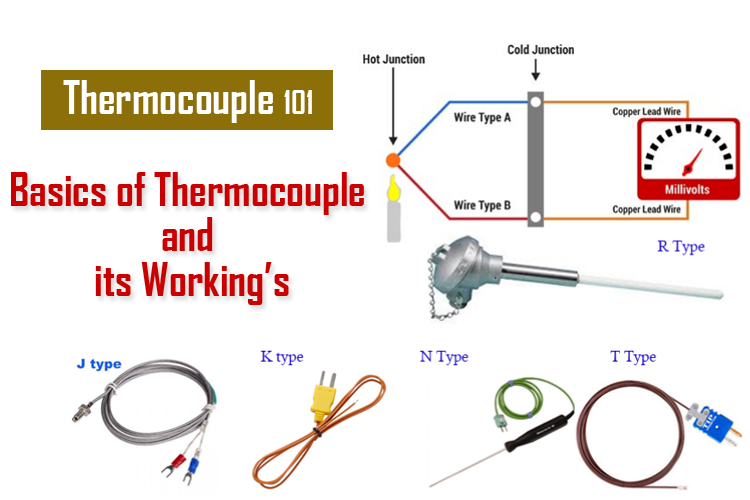
A thermocouple is a device that is used to measure temperature. It is made up of two different metal wires, joined together to form a junction. When this junction gets hot or cold, a small amount of voltage is generated in between two junctions of two transistors, depending upon the material and the amount of voltage and we can measure the temperature very accurately.
In theory, a thermocouple can be made up of any two different materials, but to improve linearity, accuracy, and temperature response specific materials are used to make the thermocouples. For example, the thermocouple made up of copper/constantan is known as the Type T thermocouple, the thermocouples made up of iron/constantan is known as the Type J thermocouple, and then finally the most popular K Type thermocouple is made up of combining alumel and chromel. When more than one thermocouples constructed from the same materials are combined they are called a thermopile. Constantan is a proprietary name for a copper-nickel alloy also known as Eureka. Thermocouples can be made and adjusted for many different applications. They can be made to increase life, fast responding or it can be made to measure a very wide temperature range.
Basic Working Principle of Thermocouple
A thermocouple works based upon the principle of the Seebeck effect. As Thomas Seebeck first discovered this effect this is known as the Seebeck effect. But for the sake of this article, we will not go into further detail about the Seebeck effect. If you want to learn more you can check it out by all means, but basically what it says, if you got a piece of wire and you got temperature differential in between two junctions a small amount of current will flow through and you will get a voltage difference, the image below shows exactly that.
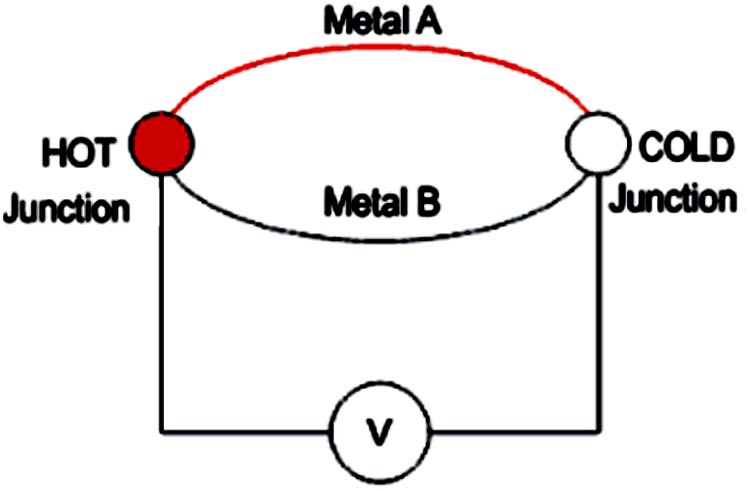
The basic theory sounds interesting. To verify that let's test the theory. To test it, I took out my multimeter, connected my alligator clips to the multimeter, and shorten them together, after that set the dial to mV range and observed the voltage, as you can clearly see the voltage reading on the multimeter is showing zero.
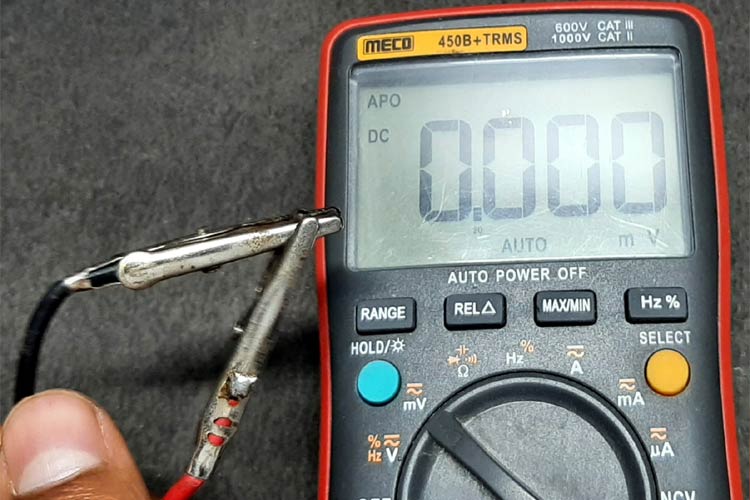
Now, I took out my gas lighter and started heating the junction or tip of the alligator clips. As you can see in the image below, the multimeter is measuring a small voltage in the microamp range.
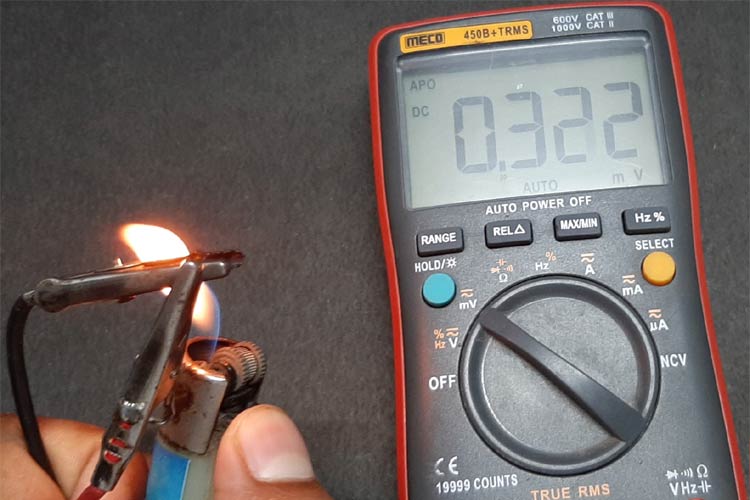
And after a few seconds, the voltage goes up even more, as you can also see in the image below.
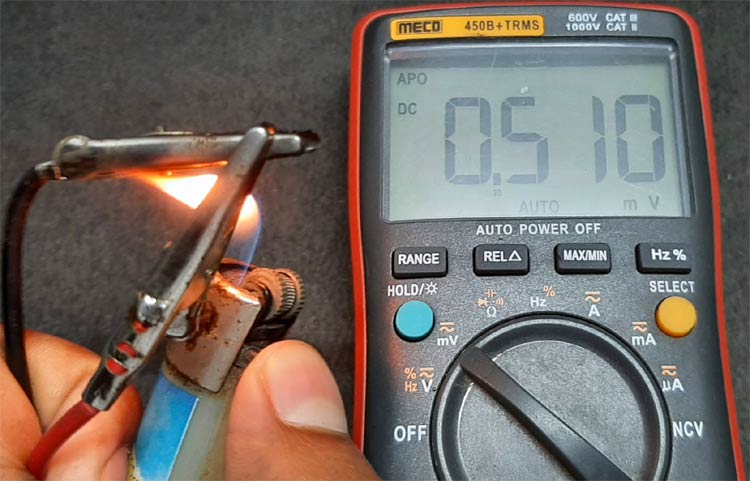
In the above experiment, you can clearly see that the Seebeck effect practically works and by measuring the voltage across two junctions, we can calculate the temperature. Sounds easy right, but as we go further into the article we will observe that measuring proper temperature with thermocouples is not so easy.
Different Types of Thermocouples
Based on the material type thermocouples can be divided into 9 categories, they are E-Type, J-Type, K-Type, E-Type, N-Type, T-Type, S-Type, R-Type, B-Type. In this section, we will discuss all those,
E-Type
The E-Type thermocouple is used where there is a need for strong signal and high accuracy.
The E-Type thermocouple provides a stronger signal compared to K-type and J-type thermocouples at a temperature range of 37.8°C or 1000°F. The E-type also provides more stability compared to K-type. This type of thermocouple is suitable for use at temperatures up to 900°C. This type of thermocouples can also be used in vacuum or in cryogenic temperatures.
J-Type
The J-Type thermocouple is made up of Iron and Constantan (copper-nickel alloy) and this type of thermocouple is suitable for vacuum, reducing, and inert environments. As this thermocouple is made out of iron, this thermocouple is not recommended for oxidizing atmospheres. For the long life of this type of thermocouple, it is recommended to use a heavy gauge of iron wire or a protecting tube. The recommended operating temperature of this type of thermocouple is 760°C
K-Type
The K-Type thermocouple is made up of Chromel and Alumel in general, but specifically, the Chromel is made out of 90% nickel, 10% chromium, and the Alumel is made out of 95% nickel, 2% aluminum, 2% manganese, and 1% silicon. These are the most common materials required to build a constant K-type thermocouple with a sensitivity of 40uV*/C. The K-type thermocouple is very accurate, so it's most used to measure temperature up to 1260°C or 2300°F. This type of thermocouple outlasts J-type of thermocouple in a high-temperature oxidizing environment because of its construction material and high accuracy. For high temperatures, it is recommended to use a ceramic material.
N-Type
The N-Type thermocouple is a very new type of thermocouple that is made to reduce the drawbacks of the K-type thermocouple. The stability of this thermocouple is very high and the temperature range is very similar to a K-type thermocouple. The sensitivity of this thermocouple is 39 µV/°C that is slightly less than that of the K-type thermocouple. This thermocouple is made out of a nickel braised alloy and used for primary temperature of 1260°C. The cost of the thermocouple is slightly higher than a K-type; it can be used in applications where operation under high temperature is necessary.
T-Type
The T-Type thermocouple is made out of copper, an alloy of copper, and nickel. In this case, it is known as the constantan alloy. This type of thermocouple is made to measure very low cryogenic temperature, and it can be used in oxidizing and reducing environments. To improve sel life, a layer of manganese dioxide is recommended. This sensor can measure a temperature range of (-200 to +200).
S, R, and B-Types
The S, R, and B-type thermocouples are mostly used for high-temperature applications. This kind of sensor ranges from anywhere from 600 to 1700 °C. And B-type thermocouple is made up of mostly platinum. For this kind of thermocouples, ceramic-based insulation is necessary.
How to Measure Temperature with a Thermocouple?
Though the theory and the working of a thermocouple look very simple, it's not easy to convert voltage generated by a thermocouple to a precise temperature reading, because the voltage signal is small. The voltage and temperature reading is non-linear, other than that you need different compensations and conditioning circuits to reduce the environment and radio noise picked up by the long wire of the thermocouple. With this little description, you can understand the difficulty of measuring temperature with a thermocouple.
To measure temperature currently with a thermocouple you need something called cold junction conditioning. As you can see from the image below
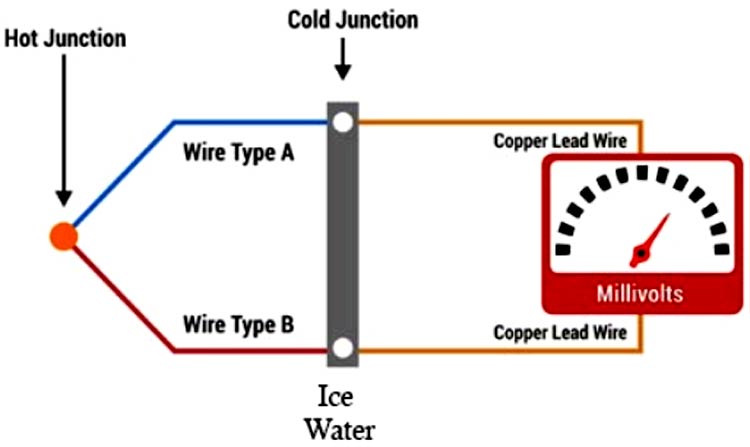
The National Institute of Standards or NIST gives us a whole bunch of tables that take ice water as a reference in the cold junction to give us a reference of the nonlinearity that exists between the hot and the cold junction. One of such tables is shown below.
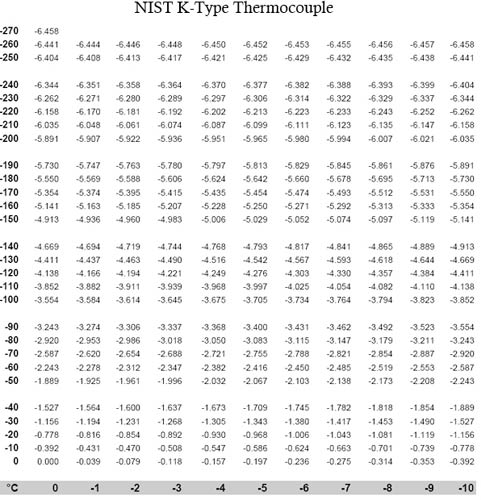
And if you want to measure temperature very accurately you need to account for these NIST tables. At first look, the table looks a bit complicated, but if you look at the bottom left corner then you will see that at 0*C the thermocouple will give you exactly 0uV. So on and so forth the hot Junction is on the Vertical or Y-axis and the cold junction is on the horizontal or X-axis. But since real-life systems work in a practical environment you need to take in all the temperature conditions to account for the temperature changes.
To make our life a lot easier and to measure temperature accurately, big manufacturers like Texas Instruments, Analog Devices, and Maxim made ICs that are specifically designed to measure thermocouple temperature and these ICs are called, Cold-Junction Compensated Thermocouple-to-Digital Converter the popular MAX6675 IC, and MAX31855, MAX31856 is such ICs that does all the hard work for you to measure temperature from a thermocouple. The MAX6675 performs cold-junction compensation and digitizes the signal from a type-K thermocouple. The data is output in a 12-bit resolution, SPI-compatible, read-only format. This converter resolves temperatures to 0.25°C, allows readings as high as +1024°C, and exhibits thermocouple accuracy of 8 LSBs for temperatures ranging from 0°C to +700°C. The most popular way to get up and running is to use an Arduino and MAX6675 IC for prototypes.
Conclusion
Thermocouple offers a high-speed temperature measurement over a wide temperature range. But they are not the most suitable choice because of their design and competition issues. In this tutorial, we gave you an idea about how a basic thermocouple works, and now you know all the different types of thermocouples and how you can measure the temperature from a thermocouple in the hard way or the easy way.









